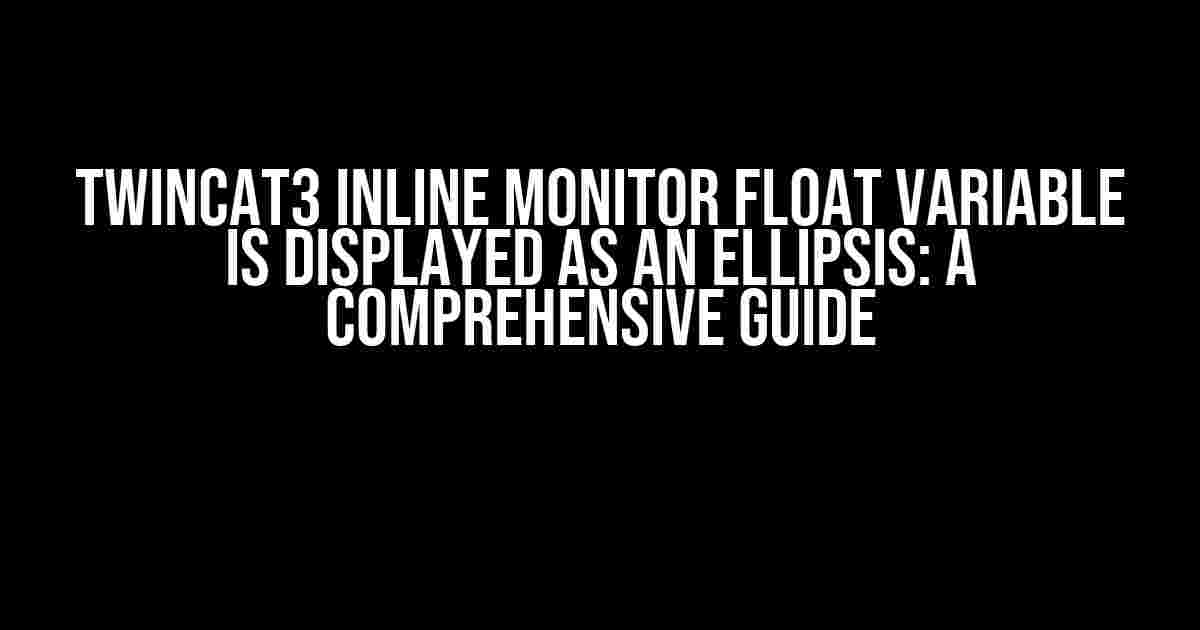Are you tired of scratching your head every time you see an ellipsis (…) in place of a float variable value in the TWinCAT3 inline monitor? You’re not alone! This frustrating issue has puzzled many TWinCAT3 users, leaving them wondering what went wrong. Fear not, dear reader, for we’re about to uncover the mystery behind this enigmatic symbol and arm you with the knowledge to tackle it head-on.
What is the TWinCAT3 Inline Monitor?
The TWinCAT3 inline monitor is a powerful tool that allows developers to debug and monitor their TwinCAT 3 projects in real-time. It provides a graphical representation of your program’s variables, making it easier to identify issues and optimize performance. However, when a float variable is displayed as an ellipsis (…), it can be a real showstopper.
Why Does the Ellipsis Appear?
The ellipsis (…) appears in the inline monitor when the float variable’s value exceeds the maximum displayable range or when there’s an issue with the variable’s data type. But don’t worry, we’ll explore these scenarios in-depth and provide you with practical solutions to overcome them.
Scenario 1: Value Exceeds Maximum Displayable Range
When a float variable’s value is too large or too small, the inline monitor may display an ellipsis instead of the actual value. This is because the monitor has a limited range of values it can display.
To resolve this issue, follow these steps:
- Open the TWinCAT3 project in the Solution Explorer.
- In the Project Explorer, navigate to the variable that’s displaying the ellipsis.
- Right-click the variable and select
Properties. - In the Properties window, locate the
Display Formatsection. - Click the
...button next toFormat String. - In the Format String dialog box, select the
Customoption. - In the
Formatfield, enter a custom format string that can accommodate the variable’s value range. For example, you can use theeformat specifier to display the value in scientific notation. - Click
OKto apply the changes.
Example format string: {0:e}
By applying a custom format string, you can ensure that the inline monitor displays the float variable’s value accurately, even if it exceeds the maximum displayable range.
Scenario 2: Data Type Issue
In some cases, the ellipsis may appear due to a data type mismatch or an incorrect variable declaration.
To troubleshoot this issue, follow these steps:
- Verify that the variable is declared with the correct data type. Check the variable’s declaration in the source code to ensure it matches the data type expected by the inline monitor.
- Ensure that the variable is initialized correctly. If the variable is not initialized, the inline monitor may display an ellipsis.
- Check for any data type conversions or casts that may be causing the issue. If you’re using a cast, ensure that it’s correct and doesn’t truncate the variable’s value.
Here’s an example of a correctly declared and initialized float variable in C++:
float myFloatVariable = 3.14159f;
By ensuring that the variable is declared and initialized correctly, you can prevent data type issues that may cause the ellipsis to appear in the inline monitor.
Additional Tips and Tricks
In addition to the solutions above, here are some additional tips to help you troubleshoot and optimize your TWinCAT3 project:
- Use the
Watchwindow to monitor variable values in real-time. This can help you identify issues more quickly and accurately. - Take advantage of the inline monitor’s
Value Tooltipfeature. Hovering over a variable in the inline monitor will display its current value, making it easier to identify issues. - Regularly review your project’s configuration and settings to ensure they’re correct and up-to-date.
Conclusion
In conclusion, the TWinCAT3 inline monitor float variable displayed as an ellipsis is a common issue that can be resolved with a few simple steps. By understanding the causes of this issue and applying the solutions outlined in this article, you’ll be well on your way to debugging and optimizing your TwinCAT 3 projects with confidence.
Remember, a well-configured inline monitor is essential for efficient debugging and troubleshooting. By following the tips and tricks outlined in this article, you’ll be able to identify and resolve issues more quickly, ensuring that your projects are completed on time and to the highest standards.
So, the next time you encounter the mysterious ellipsis, don’t panic! Simply follow the steps outlined in this article, and you’ll be back to debugging and optimizing your TWinCAT3 projects in no time.
| Troubleshooting Steps | Description |
|---|---|
| 1. Check variable declaration | Ensure the variable is declared with the correct data type. |
| 2. Verify initialization | Check that the variable is initialized correctly. |
| 3. Apply custom format string | Use a custom format string to display the variable’s value accurately. |
| 4. Review data type conversions | Check for any data type conversions or casts that may be causing the issue. |
By following these troubleshooting steps and applying the solutions outlined in this article, you’ll be able to resolve the TWinCAT3 inline monitor float variable displayed as an ellipsis issue and ensure that your projects are completed efficiently and effectively.
Happy debugging!
Frequently Asked Question
Got stuck with TwinCAT 3 inline monitor float variable displaying as an ellipsis? Don’t worry, we’ve got you covered!
Q1: Why does my float variable show up as an ellipsis in TwinCAT 3 inline monitor?
A1: Ah, that’s probably because the float value is too large or too small to be displayed in the inline monitor. Try adjusting the display format or using a smaller/larger data type to fix the issue!
Q2: Can I change the display format of the inline monitor to show the actual float value?
A2: Absolutely! You can modify the display format by right-clicking on the variable in the inline monitor, selecting “Format”, and adjusting the “Display format” to your liking. Voilà!
Q3: What if I’m using a Beckhoff device and the float variable still shows as an ellipsis?
A3: Interesting! In that case, check if the Beckhoff device’s firmware is up-to-date. If not, update it and see if the issue resolves. If it persists, contact Beckhoff support for further assistance!
Q4: Can I use a script to programmatically change the display format of multiple float variables at once?
A4: You’re a scripting wizard, aren’t you? Yes, you can create a script using TwinCAT 3’s automation interface to modify the display format of multiple variables. Check out the TwinCAT 3 documentation for more info on scripting!
Q5: Are there any limitations to displaying float variables in the inline monitor?
A5: Good question! Yes, there are limitations. The inline monitor has a limited precision for displaying float values. If your values exceed the precision, they might be truncated or displayed as an ellipsis. Be mindful of your data types and precision requirements!



